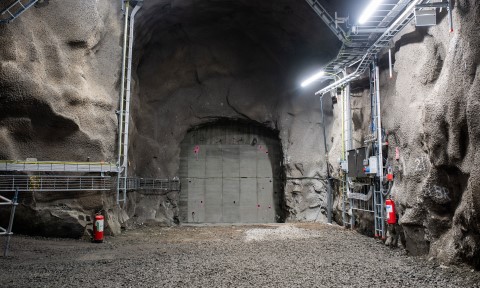SSAB, LKAB and Vattenfall’s HYBRIT pilot facility for the storage of fossil-free hydrogen gas is now in operation in Luleå. The rock cavern storage facility is the first of its kind in the world for storing fossil-free hydrogen gas. The two-year test period will now start and continue until 2024, which means that HYBRIT has taken another important step in developing the overall value chain for fossil-free iron and steel production.
After the inauguration of the pilot facility in June, initial pressure tests were conducted with water, which confirmed the facility’s mechanical stability, tightness and pressure capacity. The storage facility was then filled with hydrogen gas and even reached the maximum operating pressure of 250 bar. The commissioning of the pilot facility in Svartöberget has shown that the storage facility works according to its design and meets all safety requirements.
“The fact that this technology is now working is great news, and is an important milestone in the development of a fossil-free value chain for ore-based iron and steel production. The use of large-scale hydrogen storage means that the industry will have a more robust and plannable supply of hydrogen from fossil-free electricity, even when the electricity system becomes more dependent on the weather. This enables us to make very efficient use of our fossil-free wind power production and store the hydrogen when the weather is very windy,” says Mikael Nordlander, Director Industry Decarbonisation, Vattenfall.
“It’s very positive for us that the hydrogen gas storage pilot facility is up and running and that the technology has worked as it should up to now. That’s another important milestone. Now we’ll bring the plan to completion with test campaigns and collect important data and knowledge to make a full-scale facility possible,” says Martin Pei, CTO at SSAB.
“Hydrogen gas and its storage are central to our transition. In just four years, HYBRIT technology will be used for the production of fossil-free sponge iron on a large scale at a first demonstration facility in Gällivare. LKAB will become one of Europe’s biggest hydrogen producers, and this pilot project will provide valuable knowledge for the continuing work on creating the world’s first fossil-free value chain for the iron and steel industry,” says Lars Ydreskog, Director of Strategic Projects at LKAB.
The technology for the storage of gas in an underground lined rock cavern (LRC) involves the cavern walls being lined with a sealing layer. LRCs have been thoroughly tested with natural gas, but the pilot facility in Luleå is the first in the world to test the technology with repeated filling and emptying of hydrogen gas.
The pilot facility’s size is 100 cubic metres, and at a later stage it may be necessary to keep 100,000 to 120,000 cubic metres of pressurised hydrogen gas in a full scale storage. This means that we can store up to 100 GWh of electricity in the form of hydrogen gas, which is enough to supply a full-size sponge iron factory for about three to four days.
The HYBRIT initiative was launched in 2016 by the three owners; SSAB, LKAB and Vattenfall. The hydrogen storage facility will play a very important role in the overall value chain for fossil-free iron and steel production. By producing fossil-free hydrogen gas when there is a lot of electricity, for example when it is very windy, and using stored hydrogen gas when the electricity system is under strain, will ensure production of sponge iron, the raw material behind fossil-free steel.
HYBRIT facts:
- The HYBRIT initiative was launched in 2016 by the three owners; SSAB, LKAB and Vattenfall.
- With the HYBRIT initiative, SSAB, LKAB and Vattenfall intend to create a completely fossil-free value chain from mine to finished steel, with fossil-free pellets, fossil-free electricity and hydrogen.
- The pilot facility for the production of fossil-free sponge iron in Luleå was commissioned on 31 August 2020.
- On 24 March 2021, Gällivare was chosen as the location for the planned demonstration facility for industrial scale production. The sponge iron is used to make steel in the next stage.
- In May 2021, construction began on a storage facility for fossil-free hydrogen gas on a pilot scale next to HYBRIT’s pilot facility for direct reduction in Luleå, the storage facility began operation in late summer 2022.
- In August 2021, SSAB produced the world’s first fossil-free steel, produced using HYBRIT technology, and delivered to the customer. The test delivery was an important step toward a completely fossil-free value chain for iron and steel production and a milestone for the HYBRIT collaboration between SSAB, LKAB and Vattenfall.
- Hybrit Development AB is a research and technology development company that will deliver solutions to the facilities. Technological development will take place in close partnership with the holding companies.
- The steel industry today accounts for 7 percent of total global carbon dioxide emissions. Using HYBRIT technology, SSAB can help reduce Sweden’s carbon dioxide emissions by 10 per cent and Finland’s by 7 per cent.
- When completed, LKAB’s transition, with the help of HYBRIT technology, will reduce emissions in the global steel industry by 40–50 million tonnes of carbon dioxide a year. This corresponds to all of Sweden’s annual greenhouse gas emissions.


